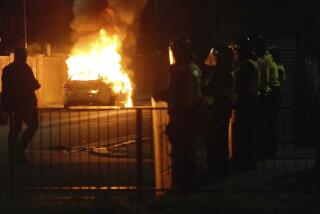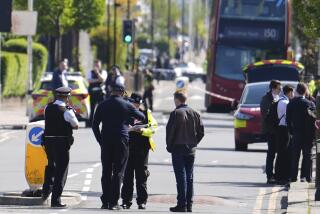Police Concede Slain Suspect Not a Bomber
- Share via
LONDON — Delivering another shock to a city under siege, Scotland Yard acknowledged Saturday that a man fatally shot at close range by a police officer on an Underground train a day earlier was innocent of involvement in the attempted bombings of the transit system last week.
As the investigation continued, police were questioning two men who were arrested Friday at low-income housing projects on suspicion of terrorism. Forensic investigators also carried out meticulous sweeps of the two apartments in the Stockwell neighborhood where the men were arrested, raising speculation that some bombers might be in custody.
But police did not reveal whether the men were among the four suspects whose faces have been widely displayed, thanks to closed-circuit television images taken Thursday, when four bombs failed to fully detonate. The bombing attempts apparently were intended to repeat the attacks that killed 52 commuters July 7.
Scotland Yard’s acknowledgment that the police shooting was a tragedy further darkened the mood of already tense and fearful Londoners. In the incident Friday morning, up to 20 well-armed plainclothes officers chased the man into the Stockwell Station and onto a subway train, where, after a brief struggle, an officer shot him five times in front of horrified passengers.
The slain man was identified as Jean Charles de Menezes, 27, a Brazilian electrician who lived in a predominantly black working-class area of South London that had become a focus of the manhunt after the failed attacks.
In a statement Saturday, police repeated the explanation that investigators had followed Menezes because he emerged from a residence that was under surveillance in the investigation of Thursday’s incidents.
The residence was in the Tulse Hill neighborhood, which is at least a mile from the Stockwell Station.
Menezes’ clothing -- witnesses said he wore a padded coat and cap despite the mild weather -- and behavior added to suspicions, the statement said. But police did not explain why Menezes disobeyed commands to stop and led officers on a chase into the station, hurdling a barrier to reach the train, according to witness accounts. Menezes was reportedly a legal immigrant.
“We are now satisfied that he was not connected with the events of Thursday, 21st July,” the terse statement said. “The circumstances that led to the man’s death are being investigated.”
Hours after the shooting, Metropolitan Police Commissioner Ian Blair had insisted that it was “directly linked” to the terrorism investigation and that the suspect’s resistance had left officers no choice.
But European police officials in touch with their counterparts at Scotland Yard said the British privately communicated a sense of unease about the incident Friday.
The officers who tailed, confronted and killed Menezes may have mistaken him for a fugitive bomber to whom he bore some resemblance, a senior European police official said. That would explain why the officers reacted violently when he fled into the subway, perhaps fearing he was about to set off a bomb concealed beneath his coat.
“The British said he was first targeted because of a physical resemblance,” the official said.
The unexpected casualty drives home the new reality of this genteel capital. Police here are proud that most do not carry guns and that officers fired weapons only 20 times from 1997 to 2004, killing seven people, according to data reported by Associated Press.
Today, heavily armed teams of officers are deployed citywide, some in uniform and some undercover, with orders to intercept would-be suicide bombers such as those whose explosives failed to ignite on three trains and a bus Thursday.
Now police will face even more pressure and scrutiny in making the kind of life-or-death, split-second decisions that are grimly routine in cities such as Jerusalem, long a target of suicide bombers.
“While we accept that the police are under tremendous pressure to apprehend the criminals who are attempting to cause carnage on the streets of London, it is absolutely vital that utmost care is taken to ensure that innocent people are not killed due to overzealousness,” said Iqbal Sacranie, secretary-general of the Muslim Council of Britain.
Shami Chakrabarti, the director of the British civil liberties group Liberty, said in an interview on Sky Television that an immediate investigation was necessary to ensure that British society did not become more divided. But she acknowledged that the police must make “knife-edge” decisions.
London Mayor Ken Livingstone blamed the bombers.
“The police acted to do what they believed necessary to protect the lives of the public,” he said. “This tragedy has added another victim to the toll of deaths for which the terrorists bear responsibility.”
Nonetheless, young, dark-skinned men may feel they’re caught between the dangers of bombers and of being mistaken for one, said Shamen Miah, 21, an engineering student of South Asian descent.
“The man wasn’t carrying a bag or a rucksack, but they still shot him,” said Miah, who was interviewed outside the station where the shooting took place. “You know, it could have been me or anyone else. Now if you ever act in a nervous or a dodgy way in the Tube you’ll get shot in the head.”
The mood on the street was complicated by the news that the manhunt has targeted South London, a tough, proud and culturally vibrant bastion of Afro-Caribbean and African cultures. Long regarded as a British Harlem, the area in recent years has seen a surge in Islamic extremism among young blacks, many of them converts.
Some residents expressed dismay at the possibility that the bombers came from their neighborhood and that one had tried to blow up a train at the Oval stop just a few blocks away.
The residents described the community as a harmonious blend of families with roots in Jamaica, Trinidad, Nigeria, Eritrea, Ethiopia, Somalia and elsewhere.
“It’s a very mixed area,” said Larry, a jovial mechanic perched on a railing across the street from the scene of a raid Friday, speaking in a melodious Guyanese accent. “We don’t got no problems here. The only problems we had are with some young boys selling weed. Everybody knows everybody.... They don’t got that many Muslims around here, there are a few. It’s so strange to hear about this happening.”
Neighbors living in and around Corfe House, a five-story project with weathered brick walls, said they thought a man who was arrested at gunpoint in a top-floor apartment Friday resembled one of the wanted photos printed in London’s newspapers -- but there was confusion about which photo. Neighbors said an Ethiopian or Eritrean family lived in the raided apartment.
Though details remain scarce, the emerging profile of the suspects diverges somewhat from that of the four July 7 bombers. Three of the dead men were British Pakistanis from Leeds in northern Britain, and the fourth was a Jamaican convert to Islam living near London.
The second group appears to include Londoners from African or Afro-Caribbean backgrounds, based on the investigation so far and their photos.
The geographical focus of the investigation points to the extremist circles of South London, which produced such figures as attempted “shoe bomber” Richard Reid, a jailhouse convert of Jamaican descent who tried to blow up a Paris-Miami flight in 2001.
Reid and Zacarias Moussaoui, a Frenchman charged in the U.S. as an accomplice of the Sept. 11 hijackers, worshiped at the Brixton mosque, which is in a faded, walk-up row house, before leaving to allegedly become disciples of extremist clerics.
Abdulhaq Ashanti, a bespectacled 28-year-old mosque spokesman wearing ethnic dress and sipping a Coke, described the teachings there as traditionalist but moderate.
The mosque’s leaders condemn suicide bombing and terrorism just as adamantly now as they did when they clashed with Reid and Moussaoui over their increasingly violent ideology, Ashanti said.
But he said the neighborhood had been affected by the post-Sept. 11, Iraq war-era surge of jihadism among young Europeans, particularly children and grandchildren of immigrants.
“There has been rising radicalization and extremist thought that has developed in some parts of South London,” Ashanti said. “Some people are using Islam to continue criminal activities. So robbing and stealing they can justify now under the banner of an Islamic garb.”
The South London suspects may have had ties to the July 7 bombers, according to reports on two television networks late Saturday. Sky and ITV reported that police had found a suspected link between the fugitives and a Wales rafting trip some of the Leeds suspects took just weeks before they died in the blasts.
Also Saturday, police said they were examining a suspicious package found in bushes in northwest London that may contain an explosive device connected to Thursday’s incidents.
Times special correspondent Hossam Hamalawy contributed to this report.
More to Read
Sign up for Essential California
The most important California stories and recommendations in your inbox every morning.
You may occasionally receive promotional content from the Los Angeles Times.










